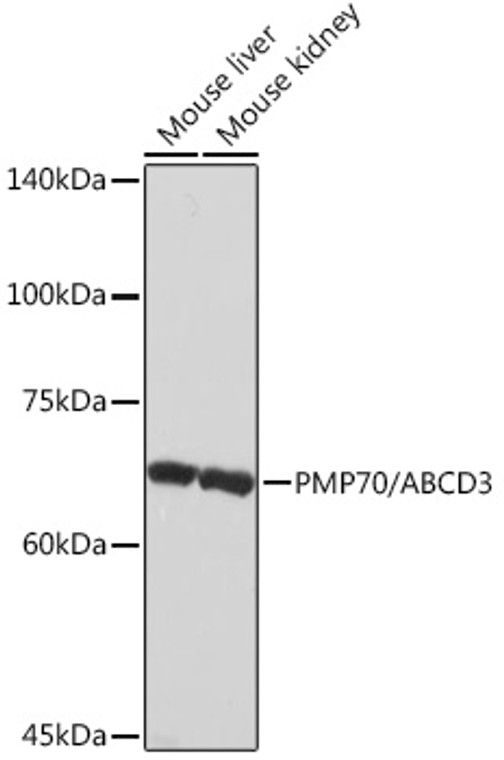| Host: |
Rabbit |
| Applications: |
WB/IF |
| Reactivity: |
Human/Mouse/Rat |
| Note: |
STRICTLY FOR FURTHER SCIENTIFIC RESEARCH USE ONLY (RUO). MUST NOT TO BE USED IN DIAGNOSTIC OR THERAPEUTIC APPLICATIONS. |
| Short Description: |
Rabbit monoclonal antibody anti-PMP70/ABCD3 (560-659) is suitable for use in Western Blot and Immunofluorescence research applications. |
| Clonality: |
Monoclonal |
| Clone ID: |
S8MR |
| Conjugation: |
Unconjugated |
| Isotype: |
IgG |
| Formulation: |
PBS with 0.02% Sodium Azide, 0.05% BSA, 50% Glycerol, pH7.3. |
| Purification: |
Affinity purification |
| Dilution Range: |
WB 1:500-1:1000IF/ICC 1:50-1:200 |
| Storage Instruction: |
Store at-20°C for up to 1 year from the date of receipt, and avoid repeat freeze-thaw cycles. |
| Gene Symbol: |
ABCD3 |
| Gene ID: |
5825 |
| Uniprot ID: |
ABCD3_HUMAN |
| Immunogen Region: |
560-659 |
| Immunogen: |
A synthetic peptide corresponding to a sequence within amino acids 560-659 of human PMP70/ABCD3 (P28288). |
| Immunogen Sequence: |
GWDSVQDWMDVLSGGEKQRM AMARLFYHKPQFAILDECTS AVSVDVEGYIYSHCRKVGIT LFTVSHRKSLWKHHEYYLHM DGRGNYEFKQITEDTVEFGS |
| Post Translational Modifications | Ubiquitinated by PEX2 during pexophagy in response to starvation, leading to its degradation. |
| Function | Broad substrate specificity ATP-dependent transporter of the ATP-binding cassette (ABC) family that catalyzes the transport of long-chain fatty acids (LCFA)-CoA, dicarboxylic acids-CoA, long-branched-chain fatty acids-CoA and bile acids from the cytosol to the peroxisome lumen for beta-oxydation. Has fatty acyl-CoA thioesterase and ATPase activities. Probably hydrolyzes fatty acyl-CoAs into free fatty acids prior to their ATP-dependent transport into peroxisomes. Thus, play a role in regulation of LCFAs and energy metabolism namely, in the degradation and biosynthesis of fatty acids by beta-oxidation. |
| Protein Name | Atp-Binding Cassette Sub-Family D Member 370 Kda Peroxisomal Membrane ProteinPmp70 |
| Database Links | Reactome: R-HSA-1369062Reactome: R-HSA-8980692Reactome: R-HSA-9013106Reactome: R-HSA-9603798 |
| Cellular Localisation | Peroxisome MembraneMulti-Pass Membrane Protein |
| Alternative Antibody Names | Anti-Atp-Binding Cassette Sub-Family D Member 3 antibodyAnti-70 Kda Peroxisomal Membrane Protein antibodyAnti-Pmp70 antibodyAnti-ABCD3 antibodyAnti-PMP70 antibodyAnti-PXMP1 antibody |
Information sourced from Uniprot.org
12 months for antibodies. 6 months for ELISA Kits. Please see website T&Cs for further guidance










